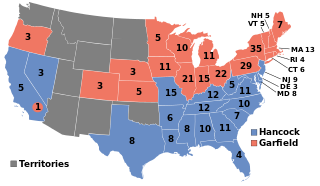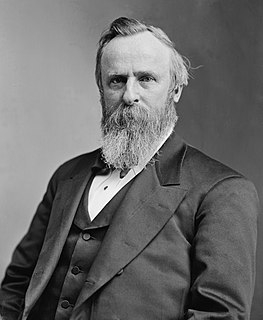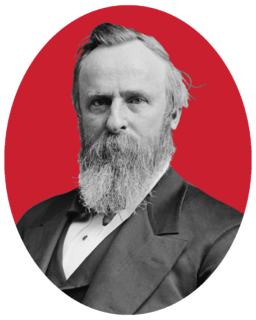Related Research Articles

The 1876 United States presidential election was the 23rd quadrennial presidential election, held on Tuesday, November 7, 1876, in which Republican nominee Rutherford B. Hayes faced Democrat Samuel J. Tilden. It was one of the most contentious presidential elections in American history. Its resolution involved negotiations between the Republicans and Democrats, resulting in the Compromise of 1877, and on March 2, 1877, the counting of electoral votes by the House and Senate occurred, confirming Hayes as President. It was the second of five U.S. presidential elections in which the winner did not win a plurality of the national popular vote. This is the only time both major party nominees were incumbent US governors.

The 1880 United States presidential election was the 24th quadrennial presidential election, held on Tuesday, November 2, 1880, in which Republican nominee James A. Garfield defeated Winfield Scott Hancock of the Democratic Party. The voter turnout rate was one of the highest in the nation's history.

Lucy Ware Hayes was the wife of President Rutherford B. Hayes and served as first lady of the United States from 1877 to 1881.

Delaware County is a county located in the central portion of the U.S. state of Ohio. It is a frequent placeholder on the List of highest-income counties in the United States. As of the 2020 census, the population was 214,124. Its county seat is Delaware. The county was formed in 1808 from Franklin County, Ohio. Both the county and its seat are named after the Delaware Indian tribe. Delaware County was listed as the 35th wealthiest county in the United States in 2020. Delaware County is included in the Columbus, Ohio, metropolitan area. U.S. President Rutherford B. Hayes was born and raised in Delaware County. It is also home to the Columbus Zoo and Aquarium.

Delaware is a city in and the county seat of Delaware County, Ohio, United States. Delaware was founded in 1808 and was incorporated in 1816. It is located near the center of Ohio, is about 30 miles (48 km) north of Columbus, and is part of the Columbus, Ohio metropolitan area. The population was 41,302 at the 2020 census, while the Columbus metropolitan area has 2,002,604 people.

Benjamin Franklin "Bluff" Wade was an American lawyer and politician who served as a United States Senator for Ohio from 1851 to 1869. He is known for his leading role among the Radical Republicans. Had the 1868 impeachment of U.S. President Andrew Johnson led to a conviction in the Senate, as president pro tempore of the U.S. Senate, Wade would have become president for the remaining nine months of Johnson's term.

Morrison Remick "Mott" Waite was an American attorney, jurist, and politician from Ohio. He served as the seventh chief justice of the United States from 1874 until his death in 1888. During his tenure, the Waite Court took a narrow interpretation of federal authority related to laws and amendments that were enacted during the Reconstruction Era to expand the rights of freedmen and protect them from attacks by white-supremacy groups such as the Ku Klux Klan.

Benjamin Helm Bristow was an American lawyer and politician who served as the 30th U.S. Treasury Secretary and the first Solicitor General.

Columbus Delano was a lawyer, rancher, banker, statesman, and a member of the prominent Delano family. Forced to live on his own at an early age, Delano struggled to become a self-made man. Delano was elected U.S. Congressman from Ohio, serving two full terms and one partial one. Prior to the American Civil War, Delano was a National Republican and then a Whig; as a Whig, he was identified with the faction of the party that opposed the spread of slavery into the Western territories, and he became a Republican when the party was founded as the major anti-slavery party after the demise of the Whigs in the 1850s. During Reconstruction Delano advocated federal protection of African-Americans' civil rights, and argued that the former Confederate states should be administered by the federal government, but was not part of the United States until they met the requirements for readmission to the Union.

Rutherford B. Hayes High School is a public high school in Delaware, Ohio, United States. It is the only high school in the Delaware City School District. The school's mascot is the Pacer, a tribute to the Little Brown Jug, which takes place in Delaware. The school is named after President Rutherford B. Hayes, who was born in Delaware in 1822.

The presidency of Rutherford B. Hayes began on March 4, 1877, when Rutherford B. Hayes was inaugurated as President of the United States, and ended on March 4, 1881. Hayes became the 19th president, after being awarded the closely contested 1876 presidential election by Republicans in Congress who agreed to the Compromise of 1877. That Compromise promised to pull federal troops out of the South, thus ending Reconstruction. He refused to seek re-election and was succeeded by James A. Garfield, a fellow Republican and ally.

The 1876 Republican National Convention was a presidential nominating convention held at the Exposition Hall in Cincinnati, Ohio on June 14–16, 1876. President Ulysses S. Grant had considered seeking a third term, but with various scandals, a poor economy and heavy Democratic gains in the House of Representatives that led many Republicans to repudiate him, he declined to run. The convention resulted in the nomination of Governor Rutherford B. Hayes of Ohio for president and Representative William A. Wheeler of New York for vice president.
In the United States, the appearance of license plates is frequently chosen to contain symbols, colors, or slogans associated with the issuing jurisdiction, which are the 50 U.S. states, the District of Columbia, the five inhabited U.S. territories, and Native American tribes, each of which independently registers motor vehicles. Regular-issue license plates for passenger vehicles typically have six or seven characters, with vanity plates having up to eight characters in a few states.

Rutherford Birchard Hayes was an American lawyer and politician who served as the 19th president of the United States from 1877 to 1881, after serving in the U.S. House of Representatives and as governor of Ohio. Before the American Civil War, Hayes was a lawyer and staunch abolitionist who defended refugee slaves in court proceedings. He served in the Union Army and the House of Representatives before assuming the presidency. His presidency represents a turning point in U.S. history, as historians consider it the formal end of Reconstruction. Hayes, a prominent member of the Republican "Half-Breed" faction, placated both Southern Democrats and Whiggish Republican businessmen by ending the federal government's involvement in attempting to bring racial equality in the South.

Pickwick is an unincorporated community in Homer Township, Winona County, Minnesota, United States.

The 1876 United States elections were held on November 7. In one of the most disputed presidential elections in American history, Republican Governor Rutherford B. Hayes of Ohio ended up winning despite Democratic Governor Samuel J. Tilden of New York earning a majority of the popular vote. The Republicans maintained their Senate majority and cut into the Democratic majority in the House.

John Russell was a Republican politician who was appointed Ohio Secretary of State from 1868-1869.

The 1880 United States elections occurred during the Third Party System, and elected the members of the 47th United States Congress. Republicans retained the Presidency and took control of the House. An unclear partisan situation prevailed in the Senate. As the first presidential election after the end of Reconstruction, this election saw the first occurrence of the Democratic Party sweeping the Southern United States; the party would carry an overwhelming majority of Southern states well into the 20th century.

Alice E. Johnson (1862–1930) was an architect from Ohio, one of the first women architects in that state. Trained by her father, she inherited his practice when he died in 1901 and ran it successfully for the next thirty years.

The 1869 Ohio gubernatorial election was held on October 12, 1869. Incumbent Republican Rutherford B. Hayes defeated Democratic nominee George H. Pendleton with 50.74% of the vote.
References
- ↑ Williams, H. Z. History of Trumbull and Mahoning Counties: With Illustrations and Biographical Sketches, Volume 2 Cleveland: H. Z. Williams & Bro., 1882; p. 67
- ↑ "Diary and Letters of Rutherford Birchard Hayes Chapter XXVIII: GOVERNOR OF OHIO -- SECOND TERM, FIRST YEAR -- 1870; pp. 88-89". Archived from the original on 2014-12-28. Retrieved 2014-12-28.